- Top Employee Onboarding Software
- Why Use Employee Onboarding Software?
- Key Features of Effective Onboarding Software
- How To Choose The Right Onboarding Software?
- Which is the Best Onboarding Software?
- Frequently Asked Questions (FAQs)
- What Is Upskill And Reskill?
- Difference Between Reskilling And Upskilling
- Upskilling for Workplace Advancement
- Reskilling for Career Transformation
- Crafting Successful Upskill and Reskill Strategies
- Upskill And Reskill Strategizing: Things to Keep in Mind
- Measuring the Impact of Skill Development Initiatives
- Frequently Asked Questions
- What’s a Skill Gap?
- Employee Skill Gap Analysis: Why Do We Need It?
- How To Conduct Employee Skill Gap Analysis?
- Addressing Skill Gaps Through Training and Hiring
- Utilizing Skills Gap Analysis for Strategic Planning
- Leveraging Employee Skill Gap Analysis: Things To Keep In Mind
- Frequently Asked Questions
- Transformative Role of AI in Talent Acquisition
- Impact of AI on Business Recruiting
- Overcoming Challenges in AI-Driven Talent Acquisition
- Starting with AI in Talent Acquisition
- Future Landscape of AI in Talent Acquisition
- Frequently Asked Questions
- HR In The Hot Seat - Challenges With Evolving Workforce
- Mastering Effective HR Management: Tips For Overcoming Challenges
- Summing Up
- The Future of HR: Key Trends for 2024
- Skill-Based Hiring
- Prioritizing Employee Experience, Engagement & Well-being
- AI-Empowered Workforce Evolution and Its Impact
- Taking Diversity, Equity, and Inclusion Beyond Mandates
- Hybrid and Remote Work
- Embracing the Gig Economy and Blended Workforce
- Transparent HR Practices
- Climate Change Adaptation in HR Practices
- Leveraging HR Analytics for Data-Driven Decisions
- Continuous Learning & Development to Improve Productivity
- The Office Buzz in 2024
- Bottom Line - HR Operating Model Needs A Shift
- Importance and Impact of Recognizing Employee Birthdays
- Professional Birthday Wishes for Employees (All Experience Levels)
- Personalized Birthday Wishes for Employees in Different Roles
- Fun Birthday Wishes for Employees (with Templates)
- Birthday Wishes for Remote Employees
- Heartfelt Birthday Wishes for Employees
- Belated Birthday Wishes for Employees
- Simple & Sweet Birthday Wishes for Employees
- Celebrating Employee Birthdays: Ideas and Traditions
- Tips and Ideas for Sending Birthday Wishes to Employees
- Closing Thoughts
- Frequently Asked Questions
- What Is An Employee Referral?
- Benefits of Implementing Employee Referral Programs
- Setting Up an Effective Employee Referral Program
- Employee Referral Email
- Employee Referral Scheme
- Overcoming Challenges of Employee Referrals
- Companies with Best Employee Referral Programs
- Employee Referral Programs: Best Practices
- Closing Thoughts
- Frequently Asked Questions (FAQs)
- Importance of Team Building Activities
- Types of Team Building Activities
- Outdoor Team Building Activities for Employees
- Indoor Team Building Activities for Employees
- Easy Team Building Activities for Remote Employees
- Team Building Activities For New Employees (Icebreakers)
- Fun Team Building Activities for Different Goals
- To Boost Communication and Collaboration
- To Reduce Stress Levels and Promote Well-being
- Aligning Team Purpose and Values with Strategic Activities
- Final Remarks
- Frequently Asked Questions
- Importance of Employee Appreciation Quotes
- Work Appreciation Quotes for Employees
- Employee Appreciation Quotes for Hard Work Recognition
- Employee Appreciation Quotes for Teamwork and Collaboration
- Appreciation Quotes for Celebrating Employee Anniversaries and Milestones
- Employee Appreciation Quotes for Strong Work Ethics
- Employee Appreciation Quotes for Project & Goal Completion
- Employee Appreciation Quotes for Quality of Work
- Employee Appreciation Quotes for Creativity and Innovation
- Appreciation Quotes for Managers
- Peer-to-Peer Employee Appreciation Quotes
- Appreciation Quotes for Employees Leaving the Company
- Employee Appreciation Quotes for Thoughtful Gestures
- Funny Employee Appreciation Quotes
- Short Employee Appreciation Quotes
- Employee Appreciation Quotes for Different Roles
- Employee Appreciation Quotes for Senior Leadership
- Creative Ways to Use Employee Appreciation Quotes
- Summary
- Frequently Asked Questions (FAQs)
- What is Employee Satisfaction?
- Importance of Employee Satisfaction
- Objectives of Employee Satisfaction
- Employee Satisfaction vs. Employee Engagement
- Key Reasons for Employee Dissatisfaction
- Strategies for Improving Employee Satisfaction
- Ways to Measure Employee Satisfaction
- Best Practices for High Employee Satisfaction
- Final Remarks
- Frequently Asked Questions (FAQs)
- How to Craft Effective Employee Appraisal Comments
- Key Areas to Focus in Performance Review
- Comments On Hard Work & Dedication
- Assessing Interpersonal Skills
- Evaluating the Ability to Collaborate & Work in Teams
- Gauging Punctuality
- Commenting on Communication Style
- Reviewing Time Management and Productivity
- Leadership in Performance Appraisals
- Assessing Creativity & Innovation
- Evaluating Problem-Solving Abilities
- Recognizing Flexibility and Dependability in Reviews
- Employee Appraisal Comments for Different Roles
- Summary
- Frequently Asked Questions (FAQs)
- Employee Grievance Meaning
- Importance of Employee Grievance Process
- Types of Workplace Grievances
- Reasons for Employee Grievances
- Employee Grievance Procedure
- Steps in the Employee Grievance Handling Process
- Employee Grievance Form Example
- Final Remarks
- Frequently Asked Questions (FAQs)
- What is Company Culture?
- Importance of Company Culture
- Types of Company Culture
- Factors Contributing to Organizational Culture
- Assessing & Developing Corporate Culture
- Company Culture - It’s not just Perks or Feels
- Good Company Culture Examples
- Developing Company Culture: Best Practices
- Closing Thoughts
- Frequently Asked Questions (FAQs)
- What is Employee Empowerment?
- Benefits of Empowering Employees
- Employee Empowerment vs. Micromanagement
- Strategies for Effective Employee Empowerment
- Role of Managers in Fostering Empowerment
- Organizational Structure Supporting Empowerment
- Overcoming Barriers to Employee Empowerment
- Frequently Asked Questions (FAQs)
- What is Employer Branding?
- Importance of Employer Branding Strategy
- How to Build an Employer Branding Strategy?
- Strategies for Building a Strong Employer Brand
- How to Measure and Boost Your Employer Branding Success?
- Examples of Strong Employer Brand Strategy
- Best Practices for an Effective Employer Branding Strategy
- Closing Thoughts
- Frequently Asked Questions (FAQs)
- What are Employee Wellness Programs?
- Importance of Employee Wellness Programs
- Examples of Employee Wellness Programs
- Real-Life Examples of Corporate Wellness Programs
- Strategies for Encouraging Participation
- Supporting Diverse Employee Needs
- Creating Comprehensive Wellness Programs
- Measuring the Impact on Business and Employees
- Closing Thoughts
- Frequently Asked Questions (FAQs)
- What is Talent Management?
- Developing a Winning Talent Management Strategy
- Models and Frameworks
- Tips for Framing Effective Talent Management Strategy
- Looking Ahead: Recent Trends in Talent Management
- Frequently Asked Questions
- Role of AI in HR: Addressing Common Challenges
- Artificial Intelligence in HR Processes
- AI Tools for HR Functions
- How to Adopt AI in HR?
- Addressing Challenges of AI in HR
- Ethical and Responsible AI Use
- The Future of AI in HR
- Closing Thoughts
- Frequently Asked Questions
- What is Performance Management?
- Elements of Effective Performance Management
- Performance Management Cycle
- Differentiating Performance Management
- Benefits of Performance Management With Examples
- Challenges faced in Performance Management and their Solutions
- Future Trends in Performance Management
- Frequently Asked Questions
- Changing Role of HRM
- Changing Role Of HR Manager
- Technology and the Changing Role of HRM
- The Rise of AI and Machine Learning in HR
- Mobile Technology's Impact on HR Practices
- The Significance of People Analytics in HR
- Navigating the Future of HR Technology
- Final Remarks
- Frequently Asked Questions
- Compensation Management Meaning
- Compensation Types
- Breaking Down The Compensation Management Process
- HR Software for Compensation Management
- Current Trends in Compensation Management
- Frequently Asked Questions
- Defining Flexible Work Arrangements
- Flexible Working: Advantages for Businesses
- Challenges of Flexible Work Arrangements
- Crafting Flexible Working Practices
- Types Of Flexible Work Arrangements
- Comparing Flexible Work Arrangements
- Real-Life Examples of Flexible Work Arrangements
- Final Remarks
- Frequently Asked Questions
- Conflict Resolution Meaning
- Conflict Origins
- Tried & Tested Conflict Resolution Strategies
- Methods of Conflict Management at Workplaces
- Conflict Resolution Strategies: Top Management Tips
- Summary
- Frequently Asked Questions
- Career Development Meaning
- Career Development Plan for Employees
- Career Development in HRM: Growth Ideas For Employees
- Issues in Career Development and Their Solutions
- Closing Thoughts
- Frequently Asked Questions
- Understanding Compensation
- Exploring Benefits
- Difference between Compensation and Benefits
- Compensation & Benefits Structure
- Final Remarks
- Frequently Asked Questions
- Defining Recruitment in HR Practices
- Exploring Talent Acquisition in HR
- Understanding Talent Acquisition vs Recruitment
- When to Recruit or Acquire Talent
- Talent Acquisition vs Recruitment: Responsibilities
- From Recruitment To Talent Acquisition
- Closing Thoughts
- Frequently Asked Questions
- Work Culture Meaning
- Types of Work Cultures
- Components of Culture
- Best Work Culture Examples Set By Top Companies
- Creating a Positive Work Culture
- Closing Thoughts
- Frequently Asked Questions
- Defining Learning vs Development
- Importance of Learning and Development
- L&D Activities for Employees
- Choosing the Right L&D Activities
- Crafting an Effective L&D Strategies
- Aligning L&D Strategy with Business Goals
- Designing Engaging Learning Journeys
- Learning and Development Process: KPIs
- ROI in Learning and Development
- Emerging Trends in L&D
- Closing Thoughts
- Frequently Asked Questions
- What Is Leadership Development?
- Key Skills for Leaders
- How To Develop Leadership Skills in Organizations?
- What Is A Leadership Development Program?
- How To Develop A Leadership Development Program?
- Example of A Leadership Development Plan
- Benefits of Leadership Development Training
- Frequently Asked Questions
- Defining Diversity Training
- Importance of Diversity Training
- What are the Types of Diversity?
- Types of Diversity Training Methods
- Diversity Training Activities
- Choosing A Diversity Training Program
- How to Implement Diversity Initiatives
- Best Diversity Training Programs (Real-Life Examples)
- Improving the Effectiveness of Diversity Training
- Tracking and Evaluating the Results of DE&I Training Efforts
- Essential Elements for Successful Diversity Training
- Closing Thoughts
- Frequently Asked Questions
- Defining Occupational Health & Safety
- Evolution of Workplace Health and Safety
- Identifying Common Workplace Hazards
- Global Impact on Occupational Health & Safety
- Managing Employee Health and Safety Risks
- Occupational Health and Safety Problems
- Future of Occupational Health and Safety
- Frequently Asked Questions
- Employee Orientation Defined
- Employee Onboarding Explained
- Orientation and Onboarding: Understanding the Difference
- Importance of Orientation and Onboarding
- Crafting Comprehensive Integration Strategies
- Quick Tips for Orientation and Onboarding
- Frequently Asked Questions
- What is HR Metrics?
- Importance of HR Metrics
- HR Metrics Examples in Recruitment
- HR Metrics Examples in Employee Retention
- HR Metrics Examples in Revenue
- Other Common HR Metrics
- Soft HR Metrics Example
- HR Metrics Formula
- Utilizing HR Metrics Effectively
- Future of HR Metrics
- Summary
- Frequently Asked Questions
- Defining Decision Making Process
- Key Concepts In Decision Making
- Decision Making & Problem Solving
- Tips For Improving Decision Making Skills
- Selected Practice Questions & Answers
- Conclusion
- Frequently Asked Questions (FAQs)
- A case(s) of miscommunication
- The devil is in the (resume) details
- One for the complaints!
- What is an Exit Interview?
- Benefits of Exit Interviews to an Organization
- How to Conduct Exit Interviews?
- Exit Interview: Sample Questions to Ask
- Overcoming Challenges of Exit Interviews
- Exit Interviews: Best Practices
- Closing Thoughts
- Frequently Asked Questions
- Technology in the Workplace
- Benefits of Tech Integration
- Technology in the Workplace: Key Functions
- How Technology Normalized Remote Work
- Workplace Technology: Top Tools and Software
- Steps for Effective Technology Implementation
- Overcoming Tech Implementation Challenges
- Ethical Considerations in Tech Use
- Keeping Pace with Tech Trends
- Closing Thoughts
- Frequently Asked Questions
- What is Ethical Leadership?
- Principles of Ethical Leadership
- Difference between Ethics and Integrity
- Importance of Ethical Leadership
- Ethical Leadership in Practice
- Overcoming Challenges
- Frequently Asked Questions
- Embracing Change Management
- Mastering People Analytics
- Enhancing Stakeholder Relationships
- Navigating Diversity, Equity & Inclusion
- Upholding Ethics and Data Privacy
- Developing Critical Thinking
- Advancing Negotiation Techniques
- Fostering Inter-departmental Collaboration
- Building Resilience in HR
- Frequently Asked Questions
- What is Mental Health?
- Benefits of a Mentally Healthy Workforce
- Prioritising Mental Health: Creating a Culture of Support
- Final Remarks
- Frequently Asked Questions
- Gen Z vs Millennials - What is the difference?
- Retain and Engage Gen Z Employees: Need and Strategies
- Strategies to Retain and Engage Gen Z Employees
- Rethinking Requirements
- Final Remarks
- Frequently Asked Questions
- Understanding Millennial Leadership Needs
- Key Leadership Skills for Millennials
- How To Develop Millennial Into Leaders
- Additional Strategies to Develop Leaders
- Learning Preferences of Millennials
- Benefits of Investing in Millennial Leaders
- Closing Thoughts
- Frequently Asked Questions
- Understanding Fluff
- Examples of Interview Fluff
- Identifying Interview Fluff
- Addressing Interview Fluff
- Seeing Through the Fluff
- Frequently Asked Questions
- What is the Gender Pay Gap?
- Is the Gender Pay Gap Real?
- Factors Affecting the Gender Pay Gap
- How Age Impacts Women’s Earnings
- The ‘Motherhood Penalty’
- Education's Role in Wage Differences
- Racial and Ethnic Disparities in Pay
- Closing the Gender Gap
- Frequently Asked Questions
- Top Weirdest Late-To-The-Office Excuses
- The Fine Art of Balancing Wit and Wisdom in HR
- Understanding Social Media Recruiting
- Crafting Your Social Media Recruitment Strategy
- Implementing Your Strategy Effectively
- Popular Platforms for Recruitment
- Navigating the Downsides of Social Media Recruiting
- Measuring Success and Adjusting Strategy
- Summary
- Frequently Asked Questions
- Who Is A High Potential (HIPO) Employee?
- Characteristics of A High Potential (HIPO) Employee
- High Potential Employee Identification
- Grooming High Potential Employees
- Why High Potential Employees Leave
- How Do You Retain High Potential Employees?
- High Potential Employee Development: Best Practices
- Closing Thoughts
- Frequently Asked Questions
- What is Digital Fluency?
- Why Digital Fluency Matters?
- Difference between Digital Literacy and Digital Fluency
- Key Components of Digital Fluency
- Achieving Digital Fluency
- Overcoming Challenges
- Future of Workforce Digital Fluency
- Frequently Asked Questions
- What is Loud Quitting?
- Pros and Cons of Loud Quitting
- Reasons Behind the Trend
- Analyzing the Impact
- How HR Can Navigate the Loud Quitting Uproar
- Preventive Strategies
- Closing Thoughts
- Frequently Asked Questions
- Defining Emotional Intelligence in HR
- Why Emotional Intelligence Matters for HR Leaders
- How To Build Emotional Intelligence in HR
- Integrating EQ into HR Practices
- Impact of EQ on Company Culture
- Emotional Intelligence in HR: Major Challenges
- Final Remarks
- Frequently Asked Questions
- Understanding Internal Job Posting
- Internal Job Posting: Pros and Cons
- The Internal Job Posting Process
- Writing Effective Ads for Internal Job Posting
- Strategies for Success of Internal Job Posting
- Summary
- Frequently Asked Questions
- Understanding Workplace Bias
- Common Types of Bias in HR
- Closing Thoughts
- Frequently Asked Questions
- What is a Dry Promotion?
- Dry Promotion: Pros and Cons for Companies
- Impact of Dry Promotion on Employee Retention
- Preventing Talent Loss After Dry Promotions
- Closing Thoughts
- Frequently Asked Questions
- What Is A Stay Interview?
- Importance Of Stay Interviews
- Benefits And Challenges Of Stay Interviews
- Planning And Conducting Stay Interviews
- Stay Interviews: 20 Sample Questions To Ask
- Best Practices For Effective Stay Interviews
- Summary
- Frequently Asked Questions
- Who Is A Boomerang Employee?
- Reasons For Returning
- Benefits Of Hiring Boomerang Employees
- Challenges Of Rehiring
- Interviewing Boomerang Candidates: Sample Questions
- Enhancing The Hiring Process
- Making Informed Decisions
- Final Remarks
- Frequently Asked Questions
- Talent Pipeline Meaning
- Significance of Talent Pipelines
- Advantages of a Talent Pipeline
- Building a Talent Pipeline
- Maintaining a Talent Pipeline
- Attracting Top Talent
- Implementing the Strategy
- Frequently Asked Questions
- What is Micromanagement?
- Recognizing Micromanagement
- Leadership versus Micromanagement
- Keeping Micromanagement in Check
- Beyond Micromanagement
- Summing Up
- Frequently Asked Questions
- Recognizing Signs Of A Bad Hire
- Understanding The Impact On Teams
- Dealing With A Bad Hire
- Preventing Future Bad Hires
- Closing Thoughts
- Frequently Asked Questions
- Defining Neurodiversity
- Importance of Neurodiversity in the Workplace
- Moving Towards Inclusive Environments
- Final Remarks
- Frequently Asked Questions
- Understanding the Generation Gap
- Multigenerational Workforce: Debunking Stereotypes
- Strategies for Bridging the Gap
- Benefits of a Multigenerational Workforce
- Final Remarks
- Frequently Asked Questions
- Defining Productivity Theatre: All Show, No Go
- 5 Key Drivers of Fake Productivity
- Solutions to Combat Productivity Theatre
- Summary
- Frequently Asked Questions
- Defining Grumpy Staying
- Why do Grumpy Stayers not Leave?
- Recognizing the Signs
- Exploring the Causes
- Understanding the Impact
- Addressing the Issue
- Taking Action: Addressing Grumpiness with Empathy
- After the Conversation
- When Grumpy Staying Continues
- Closing Thoughts
- Frequently Asked Questions
- The Rationale Behind Office Peacocking
- Impact on Company Culture
- Impact on Employees
- Case Studies: Examples of Office Peacocking
- The Downside: Potential Pitfalls of Office Peacocking
- Practical Tips for Implementing Office Peacocking
- Frequently Asked Questions
- 13 Common Mistakes Young Managers Make
- Strategies To Avoid Mistakes (Individual Growth)
- How Young Managers Can Boost Teamwork
- Learning From Errors
- Summary
- Frequently Asked Questions
- Understanding Great Regret - What causes the shift shock?
- Impact of Great Regret
- How can HR help make the situation better?
- Closing Thoughts
- Frequently Asked Questions
- Understanding the HR Budget
- Key Components of an HR Budget
- Preparing an HR Budget Step-by-Step
- Importance of HR Budgeting in Management
- Final Remarks
- Frequently Asked Questions
- What are Pre-Employment Assessments?
- Importance of Pre-Employment Testing
- Types of Pre-Employment Assessments
- 15 Tips for Creating Effective Pre-Employment Assessments
- Closing Thoughts
- Frequently Asked Questions
- Exploring the Productivity Paradox
- Understanding the Impact of Solow Paradox
- Productivity Paradox: Why it Matters for Recruiters & HRs
- Identifying Causes and Challenges
- Strategies for Enhancing Productivity
- AI & the Modern-Day Productivity Paradox
- Beyond Technology: Building a Productive Workforce
- Summary
- Frequently Asked Questions
- Understanding the Great Reshuffle 2.0
- Preparing Leaders for the Change
- HR’s Role in Handling Great Reshuffling 2.0
- The Way Ahead
- Frequently Asked Questions
- Definition Of Managerial Grid
- Managerial Grid Theory Explained
- Application Of Managerial Grid
- Criticisms And Limitations
- Evolution And Contemporary Perspectives
- Integrating Managerial Grid With Other Models
- Practical Steps For Implementing Managerial Grid
- Conclusion
- Frequently Asked Questions
- Understanding Skills Taxonomy
- Why do we Need Skills Taxonomy?
- Benefits of Skills Taxonomy
- Components of Skills Taxonomy
- Building a Skills Taxonomy: A Step-by-Step Guide
- Skill Taxonomies vs Intelligence Tools
- Closing Thoughts
- Frequently Asked Questions
- Definition Of Team Building
- Stages Of Team Development
- Top 10 Strategies For Effective Team Building
- Team Building Activities
- Best Practices For Effective Team Building
- Setting Team Building Objectives
- Challenges In Team Building
- Conclusion
- Frequently Asked Questions (FAQs)
- Defining Job Shadowing
- Unpacking the Benefits
- Setting Up the Experience
- Job Shadowing vs Internship
- Dos and Don'ts for HR Professionals
- Closing Thoughts
- Frequently Asked Questions
- Employee Journey Mapping: Meaning & Importance
- Stages of the Employee Journey
- Steps for Effective Mapping
- Employee Journey Map: Where does it begin?
- Employee Journey Map: Template
- Best Practices & Tips
- Summary
- Frequently Asked Questions
- Why are Performance Appraisals needed?
- Evolution of Performance Management
- Modern Performance Practices
- Benefits of Modern Performance Appraisals
- The Future
- Frequently Asked Questions
- Is Experience the Sole Indicator of Success?
- Why Hire Inexperienced Talent?: Key Advantages
- Skills to Look For in Inexperienced Talent
- Challenges and Considerations in Hiring Inexperienced Talent
- Final Remarks
- Frequently Asked Questions
- What is a Company Retreat?
- Company Retreat Ideas: Team-Building & Exploration
- Relaxation and Celebration
- Planning Your Retreat: Things to Keep in Mind
- Closing Thoughts
- Frequently Asked Questions
- Understanding HR Forecasting
- HR Forecasting Key Concepts
- Steps for Implementing HR Forecasting
- Common HR Forecasting Methods
- Closing Thoughts
- Frequently Asked Questions
- What is ESG?
- HR and ESG - Why Care?
- ESG in HR Strategy
- Challenges for HR
- Future of ESG in HR
- Frequently Asked Questions
- Defining the Great Betrayal
- Reasons for Its Spread
- Impact on Workers
- Impact on Corporations
- Rebuilding Trust & Valuing Employees
- Closing Thoughts
- Frequently Asked Questions
- Importance of Clear Expectations
- Setting Expectations Early
- Communicating Expectations Effectively
- Differentiating Expectations
- Reviewing and Adjusting Expectations
- Summing Up
- Frequently Asked Questions
- Understanding KRA Frameworks And Models
- KRAs vs KPAs and KPIs
- Monitoring and Tracking KRAs
- KRAs in Various Roles
- Impact of KRA Frameworks and Models on Organizational Success
- Frequently Asked Questions
- Where: The Place of Work
- When: The Time of Work
- How Much Work: Alternate Employment Models
- Who Does the Work: Intelligence
- Designing Organizations with the Four Dimensions of Work
- Summing Up
- Simplifying Processes: The Foundation of Efficiency
- Reducing Unnecessary Meetings: Reclaiming Valuable Time
- Building Strong Accountabilities: Ensuring Responsibility
- Role of HR in Addressing Inefficiencies
- Continuous Improvement: A Commitment to Excellence
- Leadership's Role in Driving Efficiency
- Conclusion: A Holistic Approach to Efficiency
- Understanding Financial Freedom
- Benefits of Empowering Employees Financially
- Empowering Employees Through Financial Literacy
- Financial Topics That Need Attention Based On Career Stage
- Summing Up
- Frequently Asked Questions
- Defining Employee Voice
- Benefits of Amplifying Employee Voice
- Strategies and Tools
- Encouraging Participation
- Closing Thoughts
- Frequently Asked Questions
- Appraisal Blues: Signs of Unhappy Employees
- Addressing Unhappiness Post-Appraisal
- Non-Monetary Solutions for Dissatisfied Employees
- Summing Up
- Frequently Asked Questions
- Women in the Middle Eastern Workforce
- Importance of DEIB
- Role of HR in Building Inclusive Workplaces for Women
- Measuring Inclusion Progress: Key Metrics
- Closing Thoughts
- Frequently Asked Questions
- Preparing for the Conversation
- Conducting the Conversation
- Best Practices for the Talk
- After the Conversation
- Helping Employees Grow
- Frequently Asked Questions
- Understanding HR Exhaustion
- Factors Leading To HR burnout
- Impact Of HR Burnout
- Strategies To Prevent And Manage HR Burnout
- Role Of Technology In Preventing Burnout
- Celebrating HR Successes
- Summary
- Frequently Asked Questions
- Common Mistakes When Hiring Young Talent
- Building Connections with Candidates
- Summary
- Frequently Asked Questions
- Walking a mile in the employee’s shoes
- Conducting Humane Layoffs
- Remote Layoffs Management
- Supporting Laid-off Workers
- Managing the Aftermath
- Wrapping Up
- Frequently Asked Questions
- Importance of Shortening Time-to-Hire
- Shortening Hiring Time: Pre-Application Stage
- Reducing Hiring Time: Application Stage
- Hacks to Shorten Hiring Time: Interview Stage
- Reducing Hiring Time: Offer Stage
- 5 Other Important Hacks & Strategies
- Final Remarks
- Frequently Asked Questions
Employee Grievance: Understanding Types, Causes & Solutions

Have you ever wondered what happens when employees feel their voices aren't heard at work? When they encounter unfair treatment or witness wrongdoing? The answer lies in understanding the concept of employee grievance.
Employee grievance management plays a crucial role in ensuring fairness, transparency, and employee satisfaction within an organization. By implementing effective strategies to address and resolve employee concerns promptly and equitably, organizations can cultivate a culture of trust and mutual respect.
Employee Grievance Meaning
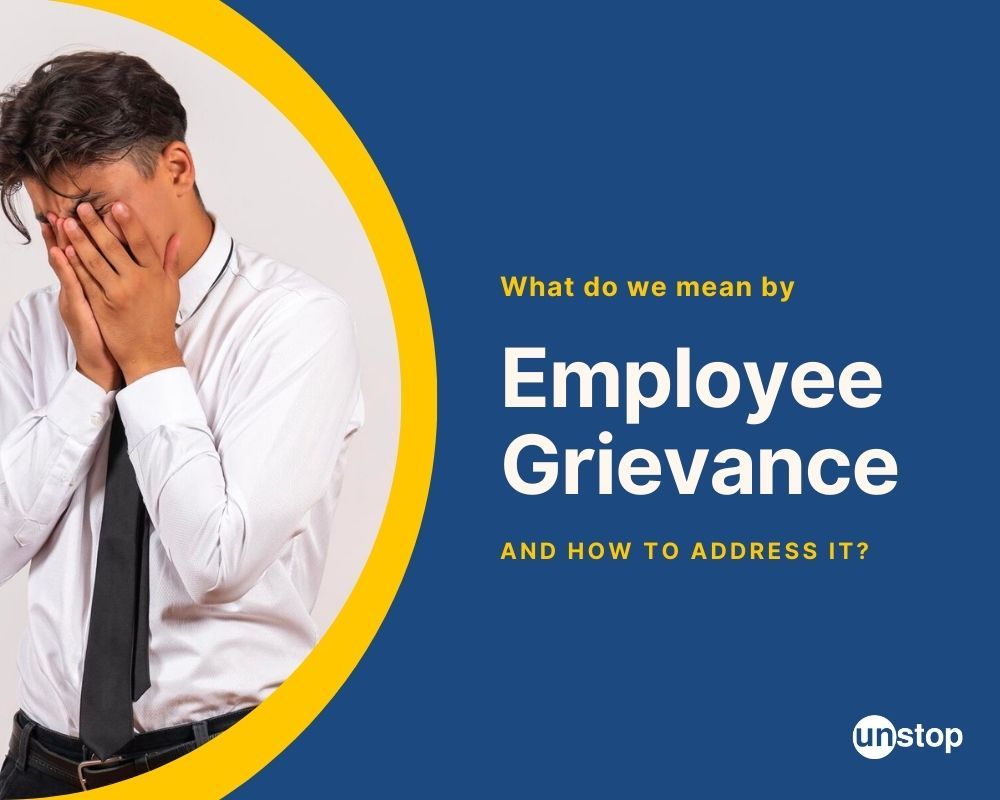
Employee grievance refers to complaints or discontentment employees experience, regarding their work conditions, treatment, or any other aspect of their employment that they believe to be unfair or unjust. This could include issues such as harassment, discrimination, workload, pay, or conflicts with colleagues or superiors.
Informal vs Formal Employee Grievance
Grievances can be informal and formal, depending on the way employees record the grievance.
Informal grievances are minor complaints or general discontentment employees experience while working. This could include interpersonal conflicts with peers, or a misunderstanding about project deliverables, etc. Ideally, such grievances can be resolved through open communication channels. In some cases, it may require managers to step in to resolve conflicts.
Formal grievances are any issues for which an employee lodges a formal complaint with the concerned department (usually, the Human Resources team). This can include instances of harassment, unfair workload, etc. An informal grievance can turn into a formal complaint if employees feel their concerns are not being heard or resolved appropriately.
In this case, the employee follows a structured process to lodge the complaint and may be required to furnish proof supporting their claims. It’s the responsibility of the employer to investigate the complaint and propose appropriate resolutions.
Employers should establish clear channels for employees to voice their concerns comfortably. Recognizing and addressing these concerns promptly can enhance workplace morale and productivity significantly.
Employee Grievance Examples
- Unfair Treatment: An employee feels they are being unfairly treated by their supervisor who consistently assigns them more work than their colleagues without valid reasons.
- Discrimination: An employee believes they are being discriminated against based on their gender as they have been passed over for promotions multiple times in favor of less qualified colleagues of the opposite gender.
In both these cases, delayed employee grievance redressal can escalate the issue, impacting employee productivity. In extreme cases, it may even lead to legal issues for the organization, and impact employers’ brand reputation.
By understanding the root causes of these disagreements, employers can take proactive steps to prevent similar issues from arising in the future. Providing training on conflict resolution techniques can also empower managers to handle grievance situations effectively.
Importance of Employee Grievance Process
Promotes Fairness and Transparency
Having employee grievance procedures in place showcases a commitment to fairness and transparency. By providing a structured process for employees to address their concerns, organizations create an environment where everyone feels heard and valued. This can lead to increased trust between employees and management.
Prevents Escalations
Implementing formal grievance procedures also prevents minor issues from turning into major conflicts. When employees know there is a clear path for addressing grievances, they are more likely to speak up early on before situations escalate. This proactive approach can significantly reduce tension in the workplace and foster a harmonious atmosphere.
Fosters Trust & Inclusivity
The presence of robust grievance mechanisms promotes open communication channels between all levels of staff, creating a sense of inclusivity where every voice matters. Employees who feel heard are more engaged with their work, have greater faith in the organization, and tend to be more productive, leading to better overall performance for the organization.
Types of Workplace Grievances

Discrimination and Harassment
Workplace grievances may arise due to discrimination or harassment, where employees feel unfairly treated based on their race, gender, caste, disability, or other protected characteristics. This can lead to a toxic work environment affecting morale and productivity.
Bullying, offensive remarks, and unfair hiring practices are some examples of discrimination and harassment issues in the workplace. Specific examples include:
- Bullying behavior from a supervisor towards a subordinate.
- Offensive comments about an employee's religious beliefs.
Unfair Treatment and Workload
Unfair treatment complaints often revolve around favoritism, lack of recognition for hard work, or inconsistent disciplinary actions. Excessive workload grievances occur when employees feel overwhelmed with tasks beyond their capacity. Specific examples can be:
- A manager consistently assigning more tasks to one employee over others.
- Employees overlooked for promotions despite meeting performance targets.
Compensation and Management Policies
Employees may file grievances related to compensation, such as inadequate pay raises or discrepancies in salary compared to industry standards. Grievances regarding management policies could include dissatisfaction with performance evaluations or lack of transparency in decision-making processes. Some examples are:
- Employees expressing concerns about not receiving annual bonuses as promised.
- Staff questioning the fairness of promotion criteria set by management.
Working Conditions
Employees may also be concerned about working conditions, like long working hours, unjustified overtime, or even the physical environment that impacts their mental and physical health. In such cases, employees may file grievances about the lack of basic workplace amenities. Take the following examples:
- Physical environment: cleanliness on the office floors or in the kitchen, health and safety hazards in the workplace, etc.
- Working Conditions: Consistently working over weekends without additional pay or comp-offs.
Reasons for Employee Grievances
There is no fixed list of reasons for employee grievances, but a few common causes are:
- Poor Communication: Lack of clear communication from management can lead to misunderstandings and frustration among employees. When instructions are unclear or inconsistent, it can result in mistakes and conflict within the team.
- Lack of Transparency: When there is a lack of transparency regarding company policies or decisions (especially about promotions or bonuses), employees may feel left out or uninformed. This can create a sense of distrust and dissatisfaction among the workforce.
- Inadequate Training: Insufficient training programs can leave employees feeling unprepared for their roles, leading to stress and anxiety about performance. Without proper guidance, employees may struggle to meet expectations, causing grievances to arise.
- Inefficient onboarding: When new hires receive inadequate onboarding processes, they might not fully understand their responsibilities or how to navigate workplace challenges effectively. This lack of support can contribute to feelings of isolation and frustration.
- Unrealistic Deadlines: Setting unrealistic deadlines can put excessive pressure on employees, leading to stress, anxiety, and a sense of being overwhelmed. When employees are constantly expected to meet unattainable goals within unreasonable time frames, it can negatively impact their morale and job satisfaction, potentially leading to grievances.
- Lack of Due Recognition: Employees may feel undervalued and unappreciated when their hard work and contributions go unnoticed or unrewarded. This can lead to feelings of frustration and resentment, ultimately resulting in grievances.
Want to motivate your employees? Check out this exhaustive list of employee appreciation quotes for different occasions.
Employee Grievance Procedure
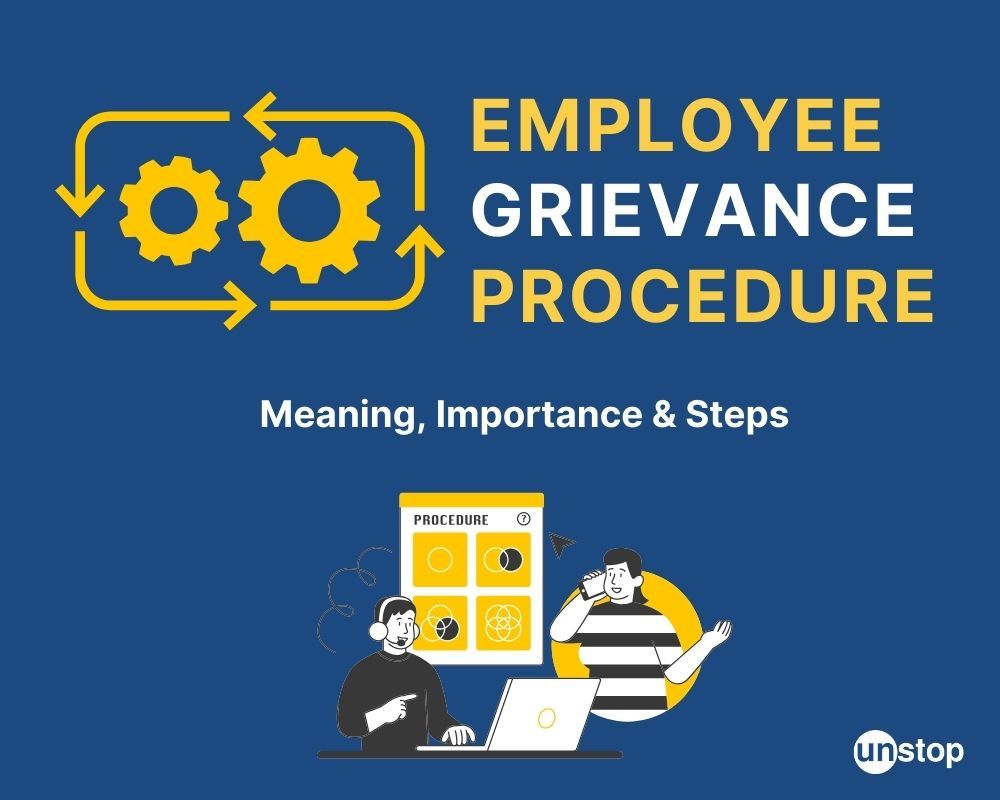
What is it?: An employee grievance procedure is a formal process established by an organization to address and resolve complaints or concerns raised by employees regarding their work environment, working conditions, colleagues, or management.
What does it include?: This procedure typically outlines the steps that employees should follow when they have a grievance, such as who to report the grievance to, how it will be investigated, and what actions will be taken to address the issue.
What’s the end goal?: The goal of an employee grievance procedure is to provide a fair and transparent mechanism for employees to raise their concerns and ensure that they are addressed in a timely and effective manner.
Why is it important?: Having clear procedures in place sets expectations for both employees and employers on how complaints should be handled. This clarity reduces misunderstandings and ensures consistent treatment across all cases.
By establishing well-defined formal processes, organizations create a transparent environment where employees feel heard and valued. Having documented grievance procedures can also protect companies from potential legal challenges by showcasing that proper steps were taken to address complaints.
Steps in the Employee Grievance Handling Process
Here's a breakdown of the typical steps involved, from the organization's perspective:
1. Informal Resolution Encouragement
- Proactively encourage employees to discuss concerns informally with their supervisors or designated representatives.
- Foster a culture of open communication and active listening to address issues early on.
- Provide clear guidelines on informal resolution procedures, encouraging timely and respectful communication.
2. Formal Complaint Intake
- Establish a well-defined process for receiving and acknowledging formal complaints, adhering to confidentiality guidelines.
- Offer various channels for submitting complaints, such as written forms, online portals, or designated personnel. HR departments can also implement anonymous suggestion boxes for employees to share their grievances.
- Clearly communicate timeframes for receiving and acknowledging complaints to set expectations for both parties.
3. Thorough Investigation
- Assemble an impartial team to investigate the grievance objectively and promptly.
- Conduct interviews with relevant parties, gather evidence, and document the investigation process meticulously.
- Ensure fair and respectful treatment of all individuals involved, maintaining neutrality throughout the investigation.
4. Grievance Hearing (Optional)
- Depending on the complexity or severity of the grievance, offer a formal hearing opportunity.
- Allow the employee to present their case, answer questions, and potentially be accompanied by a representative.
- Provide a structured forum for discussion and fact-finding while maintaining order and professionalism.
5. Decision and Communication
- Issue a formal decision based on the investigation findings and applicable policies, clearly outlining the rationale.
- Communicate the decision promptly and professionally to the employee, adhering to confidentiality as needed.
- Offer clear explanations and, if applicable, explain any corrective actions or disciplinary measures taken.
6. Appealing the Decision
- Establish a defined appeals process for employees who disagree with the initial decision.
- Allow opportunities for further review and consideration, ensuring fairness and objectivity.
- Communicate clear timeframes and procedures for appeals, upholding organizational policies and maintaining order.
7. External Mechanisms
- Be prepared for the possibility that employees may pursue external avenues, such as legal channels or government agencies.
- Cooperate with relevant external authorities when necessary, providing appropriate information and documentation.
- Communicate openly and transparently with employees while respecting legal and confidentiality requirements.
Additional Considerations:
- Regularly review and update grievance policies and procedures to ensure effectiveness and compliance with relevant laws.
- Provide training and resources for employees and managers on understanding and navigating the grievance process.
- Promote a culture of fairness, respect, and open communication to minimize the need for formal grievance procedures.
By implementing a well-defined and transparent grievance process, organizations can foster a positive work environment where employee concerns are heard and addressed fairly, building trust and strengthening employee relations.
Employee Grievance Form Example
Here’s a sample employee grievance form:
Employee Grievance Form
Please complete this form to report a grievance, concern, or complaint you have about your employment. All information provided will be treated confidentially.
Section 1: Personal Information
Employee Name:
Department:
Job Title:
Supervisor Name:
Section 2: Grievance Details
Nature of Grievance: Briefly describe the issue you are raising.
Date(s) of Occurrence: When did the incident(s) occur?
Location(s) of Occurrence: Where did the incident(s) happen?
Individuals Involved: List any individuals involved in the situation, including witnesses.
Specific Details: Provide a detailed description of the events leading up to and including the grievance, including any actions taken to resolve the issue informally.
Desired Outcome: What outcome are you hoping to achieve by filing this grievance?
Section 3: Additional Information
Have you attempted to resolve this issue informally? If yes, please explain your efforts and the results.
Do you have any witnesses or evidence to support your claim? Please list any witnesses or provide copies of any relevant documentation.
Is there anything else you would like to add?
Section 4: Acknowledgement
I understand that all information provided in this form will be treated confidentially. I certify that the information provided is accurate and complete to the best of my knowledge.
Employee Signature:
Date:
Please submit this form to [insert designated individual or department name].
Note: This is a sample form and may need to be adapted to fit your organization's specific needs and policies.
Final Remarks
Employee grievances can significantly impact workplace dynamics and employee morale. Understanding the types, causes, and effective handling of grievances is crucial for fostering a positive work environment. By implementing clear grievance procedures and actively resolving issues, organizations can mitigate conflicts and enhance employee satisfaction. It is essential to prioritize open communication, fairness, and timely resolution to address grievances effectively.
Frequently Asked Questions (FAQs)
1. What are employee grievances?
Employee grievances refer to concerns, complaints, or issues that employees may have in the workplace regarding their work, working conditions, colleagues, or management.
2. How can organizations effectively handle employee grievances?
Organizations can effectively handle employee grievances by establishing clear grievance procedures, providing a safe and confidential platform for employees to voice their concerns, conducting fair investigations, and implementing timely resolutions.
3. Why is it important for companies to address employee grievances promptly?
Addressing employee grievances promptly is crucial as unresolved issues can lead to decreased morale, productivity loss, increased turnover rates, and potential legal implications for the organization.
4. What are some common causes of employee grievances in the workplace?
Common causes of employee grievances include unfair treatment by managers or colleagues, lack of communication within the organization, inadequate recognition or rewards for work performance, and discrimination based on various factors like gender or ethnicity.
5. How do organizations benefit from having formal grievance procedures in place?
Organizations benefit from having formal grievance procedures by promoting a transparent and supportive work environment fostering trust between employees and management. It also helps in resolving conflicts efficiently while maintaining a positive organizational culture.
Suggested Reads:
- Business Analyst Job Description Template & Samples For 2024
- Sales Executive Job Description: Get Template, Samples & Top Tips
- Employee Appraisal Comments: 115+ Phrases Divided By Skills & Roles
- Quizzes For Assessment Of Candidates for Upskilling, Promotion, & Hiring
- Employee Referral 101: Unlock Benefits, Best Practices & Top Schemes
I’m a reader first and a writer second, constantly diving into the world of content. If I’m not writing or reading, I like watching movies and dreaming of a life by the beach.
Login to continue reading
And access exclusive content, personalized recommendations, and career-boosting opportunities.
Subscribe
to our newsletter
Blogs you need to hog!
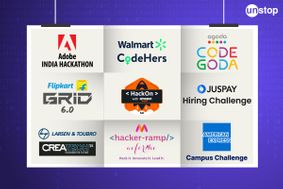
Organize Hackathons: The Ultimate Playbook With Past Case Studies

What is Campus Recruitment? How To Tap The Untapped Talent?

Lateral Hiring: A Complete Guide To The Process, Its Benefits, Challenges & Best Practices
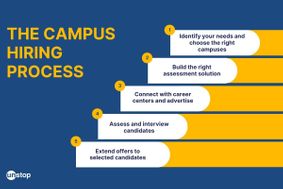








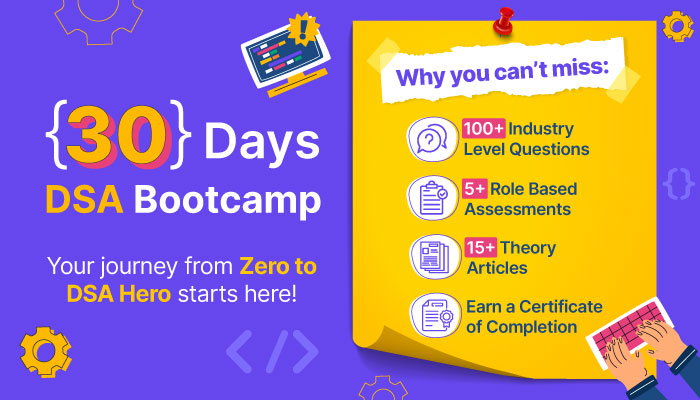



Comments
Add comment